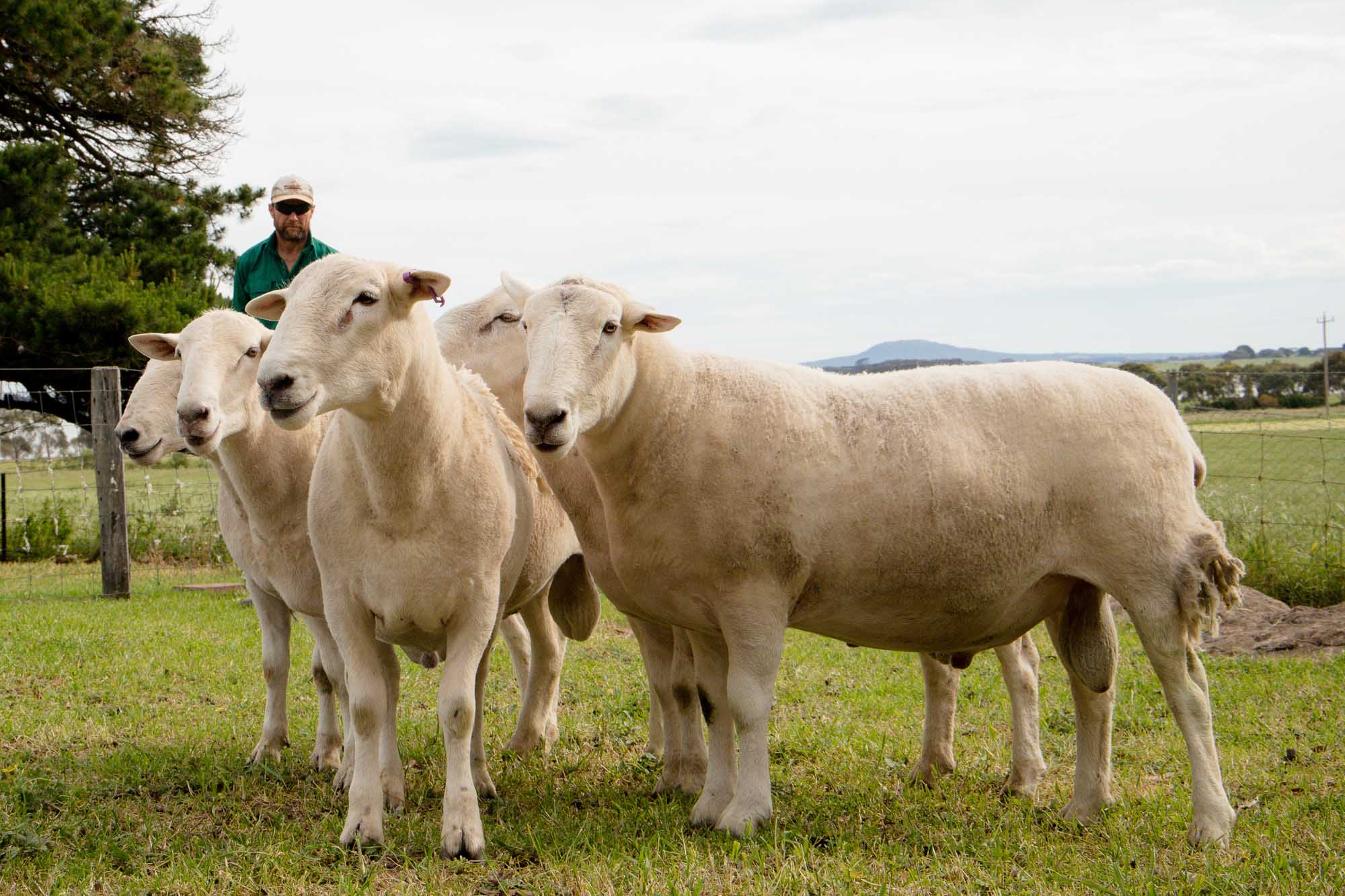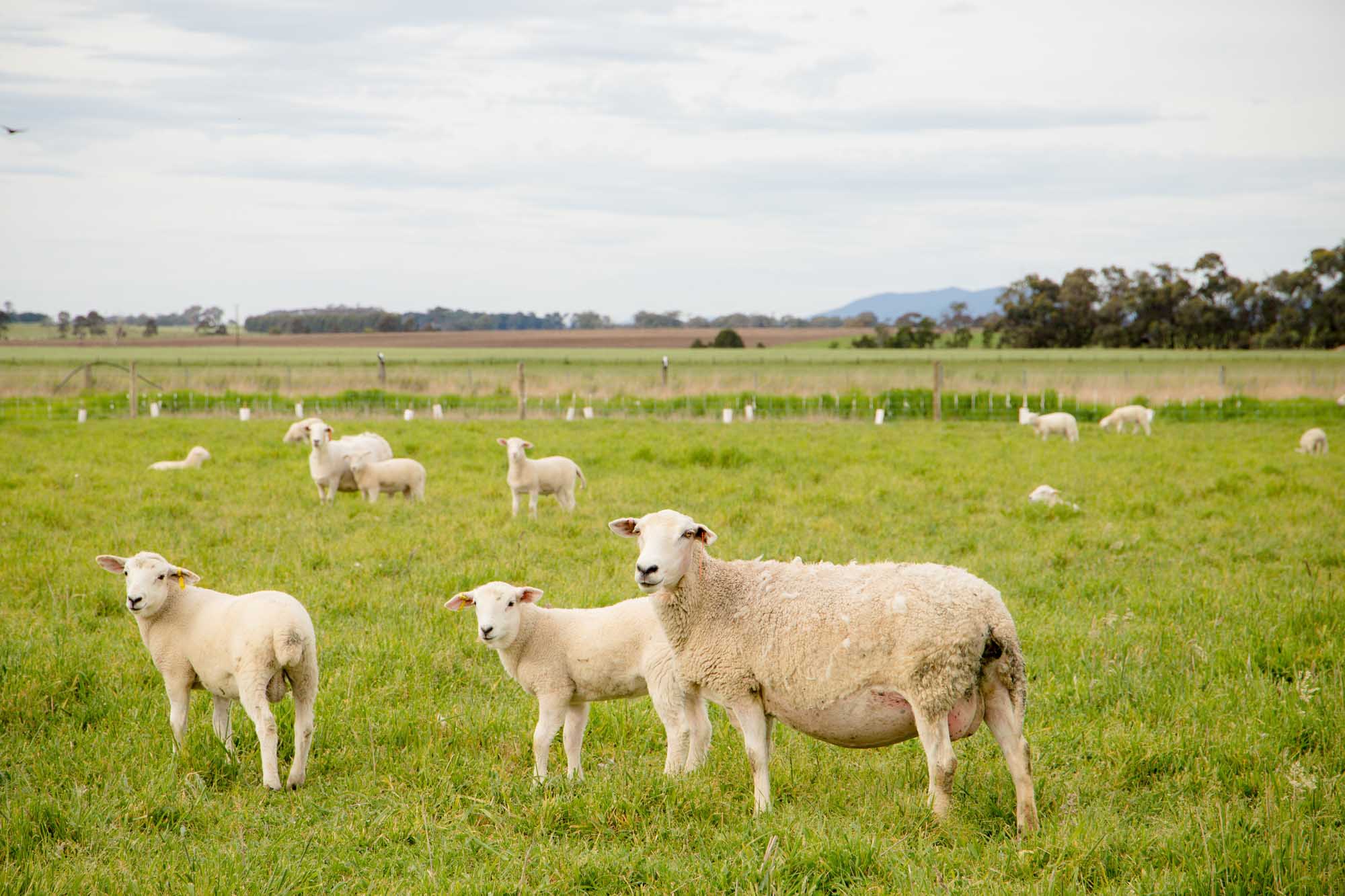

Our aim is to breed robust, easy-care sheep, producing lambs with good carcase shape, cover and finish at a wide range of weights (14kg-25kg carcase).
This is achieved through performance recording, accurate benchmarking, rigorous visual and genetic selection using Lambplan ASBV’s. We record as much data as we can to give strength to our ASBVs, as we rely heavily on these for production trait selection.
Our sheep are selected to shed clean most years, eliminating all costs and risks associated with wool growth and management. They must be highly fertile, conceiving at 6 to 8 months of age and successfully rearing lambs. They are selected for positive genetic muscle and fat – these body reserves are ‘doing ability’ which reduces feed costs, improves survival, adds to carcase value and increases marketing options. They are worm resistant and resilient and can survive and produce in high rainfall zones, with just one or two drenches a year. Footrot resistance is achieved through a strong focus on structure and selection of animals with the ability to develop immunity.
Shedding
Our sheep shed as a response to day length change (as do all other animals). As the days get longer, fibre release is triggered. Some sheep are very sensitive to day length change and can shed 3 to 4 times between July and January. Others only just make it clean by January and some are left with a mohawk or saddle of wool. In Western Victoria the variation in day length is from 9 to 16 hours and therefore some sheep need only 1.5 hours of day length change and others need 7 hours or more to fully shed. This also explains why sheep need to be more sensitive in Queensland and less sensitive in Tasmania to shed clean. Lambs born in Spring don’t always shed clean in their first summer. The better condition they are in, the more sensitive to day length change they are.
From a production perspective, it makes little difference if sheep retain some wool, they just don’t look as tidy, and some may need to be shorn once or twice in their lives if they have life threatening wool. Marketing half woolly sheep can be harder, because they don’t present as well in the yards, but we haven’t had any issues over the hook (do not expect any skin value).
To advance our sheep we are introducing genetics from the very best performance recorded Maternal Composites from Cashmore Park. Our aim is to increase growth and number of lambs weaned, without losing the existing qualities we have in our sheep. Unfortunately, this reintroduces wool, but by the second cross, we start to get some full shedders carrying positive genes that we can go forward with. Some of our half woolly sheep are carrying advanced genetics. If you are trying to breed wool off, you need to select the most sensitive to day length change, or earliest shedders to increase the sensitivity of the next generation. It takes 2 to 5 crosses or 4 to 10 years to get a large percentage shedding clean. It is quicker and easier to begin with ewes that are already shedding, if they have the production traits you require.
Reproduction
Our mature ewes (2 years and older) scan around 165% and wean 150%, so although our conception rates are not breaking any records, our survival rates are. The number of lambs weaned is an area we are working hard on. We have a lot of diversity in our own flock now, with accurate figures to select from, and will continue to introduce impact sires in this area. Lamb survival is a priority for us, we can’t see the point of extra conception if the likelihood of survival is low. Lambplan is introducing a survival index in the near future, which will assist us in maintaining this trait in our flock.
Muscle and Fat
To produce a saleable trade lamb, the loin area needs to be full of muscle and covered with some fat, otherwise you are delivering a secondary product and will lose marketing options.
Sheep positive for genetic muscle and fat have a built-in camel hump and lose condition more slowly when times are tough, gaining condition more quickly when times improve. Muscle and fat are highly correlated (if you select for one you will get the other). We select for muscle first because muscle is faster than fat to download in times of need (at the point of lambing and early lactation) and faster to upload when the pressure is off (weaning). Muscular ewes can do the job better and recover more quickly. Muscle also has more value on a carcase, so we select for muscle first and let fat come along for the ride.
Positive genetic fat is linked to lamb survival and meat-eating quality. One kg of fat is equal to 6kg of meat as an energy store. This is very important in a ewe flock, allowing them to store excess Spring feed as fat to maintain them through Summer. Our aim is to have the flock average muscle at +2 PEMD and fat at 0.0 PFAT. Currently (Nov 2021) +0.8 PEMD and -0.4 PFAT.
Worm Resistance and Resilience
Our flock average is in the top 10% for post weaning FEC of all sheep in the maternal database. Our 2021 average is -60% for PFEC. We also select for growth – animals that can grow under a worm load clearly have resilience. This massively reduces the risks to animal health and production loss to worms in our high rainfall environment. Also reducing labour and chemical costs needed to manage worms. Read more and view our data: CLICK HERE
Footrot Resistance
Footrot resistance is about structure and a genetic predisposition to developing antibodies to resist bacterial attack (hoof colour is not the best indicator).
Good hoof structure gives the infected area between the toes the opportunity to dry out, killing the bacteria on the surface of the skin. Short hooves which stand up straight, with a gap between them appear to be most resistant.
A sheep’s ability to develop antibodies depends on its ancestry. Most English based breeds have had a long period of exposure (possibly thousands of years) and have developed good immunity. If you look at sheep breeds that dominate high rainfall areas, they are all English based. Our base breeds are Wiltshire Horn, Wiltipoll, Dorper and Maternal Composite. We have approximately 80% English base, so have resistant genes. The combination of good structure and genes, which build immunity give the sheep the capacity to heal themselves.
Once pastures have dried off properly, every sheep is inspected and given a score for its ability to heal without assistance from benign footrot (no foot bathing). Males are culled if they have not healed completely. Approximately 25 to 30% are culled at this point (this percentage is reducing every year), and if females have nearly healed and are above average for most other traits they may get a second chance.
